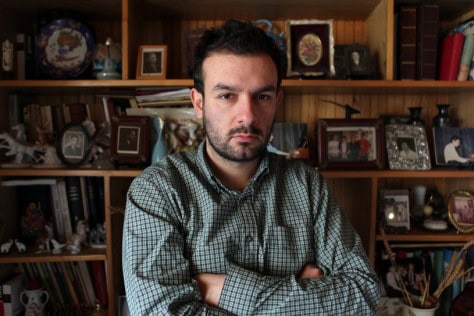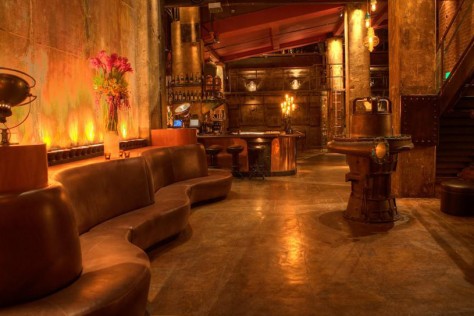How did Graniph start and when? What was the catalyst for its creation?
In the late-90s, three graphic designers started to print T-shirts… they didn’t find any T’s which they really liked at that time and wanted to print “cool western typography” designs. Their first T’s did so well that they decided to open their first store in Shimokitazawa [near Tokyo]. The Design T-shirts stores Graniph started in 2001 with the concept that you see today.
Japan is notorious for the expensiveness of its clothes; a T-shirt might cost something like $80 at BEAMS, a pair of jeans will be at least $200. While this isn't uncommon in the U.S. or elsewhere, there doesn't seem to be the same array of options in Japan. Why are all Graniph shirts priced at just ¥2500/$20?
You know that Tokyo was, for a long time the most expensive city on this globe… it’s often written that the Japanese like to spend money and that spending lots of money gives oneself the feeling of a high life standard, status, etc.; nothing that bad in fact, but unfortunately [the stock market crashed and that was the end of the Bubble Economy stories].
Young people started to rethink in that era. For example the ni-to (neat), a scene of young guys ans girls who
just rejected to do anything for the society, and they didn't study or work for a company as their fathers did.
The thought was, “[Don't worry so much about day-to-day spending if it can all collapse again!]—enjoy life!” (Some of those guys would, for example, get dark studio tans and carry their surfboards through the Tokyo streets without even the intention to go surfing at all; everything was just an accessory.)
Other young people started to travel around the world. They stopped following the high school, college, salaryman-for-life pattern, too.
Then others started to build up their own companies and design studios–like the Graniph guys did. It was not important anymore to [establish a top-notch] career in business… and many people started designing. But with different values! They understood that the market isn’t willing to pay for a single product as much as before, that the consumers had different values as well; they had to build up a sort of customer intelligence.
Graniph decided to offer a single T for 2000 Yen/20US$, because it is basically just a T-shirt and they knew that they would have so many ideas and would want to create so many new designs that [couldn't exclusively sell just one design or piece forever]. Graniph strives to give the customers the opportunity to buy up all our cool ideas, but still have the chance—and the money!—to see a new movie, buy a cool pair of sneakers or a new
CD and so on… this is basically the reason why Graniph started reasonably priced and hasn’t changed the price since then. One T is now ¥2500 and two bought together, ¥4000.
How many new designs do you release monthly?
Usually we have 70—100 new designs, but over the summer we increase the number to 130, including cut & sewn products, bags, and cap designs.
How do you select your artists and print new shirts in such a timely fashion?
30% of all designs are made in-house at Graniph; 30% are from Japanese artists and designers; 30% are international artists; 10% are collaborations, awards and special event T’s. All the in-house designs are creatively directed in our design studio in the certain Graniph style, inspired by European design books of the 60’s and 70’s, old flyers, typography, pictures, and catalogs. We are seeking for illustrators, graphic designers, photographers constantly and collaborate with the people who’s style fits to the Graniph concept.
Recently, you've been expanding and not just making T-shirts. You make sweatshirts, bags, hats, etc. When did you start experimenting with other garments?
We started making sweatshirts, bags, and hats pretty much from the beginning. It is obvious that T-shirts can’t be sold in Winter when it’s colder… so Graniph just had to react on the seasonal and customer needs. Bags and hats are easy to wear accessories and look really good with prints, so it was an easy decision.
What is it with T-shirts that makes them so aesthetically appealing? Why do you think there are literally thousands of T-shirt companies… with the number increasing daily?
A T-shirt is just the easiest garment on earth to make: everyone can wear it; they're available in all kinds of colors; anyone can print one by on their own (how often do you hear among your friends something like, “I got such a nice idea for a handkerchief…”? People are always saying, rather, “Whoo! I've got such a great idea for a T-shirt!”) And—most importantly, it’s a perfect canvas. I explain to people often that we kind of create a wearable gallery… and that's basically it. While you usually see illustration in/on something static—a book, CD sleeve, gallery, museum, magazine—a T-shirt moves around with the person and expresses his/her mood, background, style etc. in the easiest way.
And importantly, how does Graniph stand out from the other companies?
We only produce in limited editions or up to 1000 T’s per design. Very rarely do we re-produce designs that have been sold amazingly well. Due to collaborations with international artists, we have always new ideas in the stores; it's very refreshing to mingle this with the Graniph in-house designs.
For our international T-shirts design award [last year] we received about 15,000 entries by all these young guys from New Zealand to Finland and Hokkaido to Zambia—it was just amazing! We are very interactive and don’t rely only on our own design-style. That is something new. I would say that “collaboration” and “interactivity” are pretty marketable words internationally.
I've always wondered why it is that you use so much German type on your designs. It seems that French is more in vogue than German in Japan.
(It’s not, because I’m German! I have nothing to do with it!)
I think that German is as much in vogue as French in Japan. Many store names or products have names inspired by German. Especially for graphic designers who all like the modern grid system, Helvetica, and other clean typefaces, German is a perfect match. (Especially with the funny Umlaut-dots [ä, ü] . French, with all kind of accents, breaks up the clean outlines, though.
What are Graniph's future plans? U.S. stores? More garments? More outlets?
On February 28th the first Graniph Australia store will open, and contacts with US and Europe are growing right now.
How do you select the neighborhoods in which you make a Graniph store and what's the process for decorating the interior?
The interior fits to the T-style: teak wood, antique furniture from the 60s/70s living room style (without the pop-art wallpaper, of course) and often a chandelier as the light is nice and doesn’t cast annoying shadows on the T-shirt graphics.
The neighborhoods are streets where all the fashion lovers are gathering. As the Graniph stores are rather small, there aren’t so hard issues to find a tiny spot in a great area.
Last year you began the Graniph Design Award competition. What brought this on and how successful was it?
We received 15,000 entries from young creatives from about 46 countries. We sent flyers to all this galleries, universities, record stores, etc. where [cool, interesting people] are hanging out. Furthermore, we sent flyers to select stores, the owners of which contacted us afterwards about the possibilities to stock Graniph T’s. To get in contact with new artists and also (potential) new business partners it was amazingly successful. Remember: interactivity!
Just recently you finally started offering your products internationally. Why did it take so long and how has the reception been? Why now and not… four, five years ago?
Four , five years ago, Graniph just started to work in the way as it is displayed now. But that time it was a purely Japanese company without any contacts overseas. This has changed now, relationships have been stabilized and so on. [We had to first establish these things to progress and branch out to into an international marketplace.]
You've been working on a lot of collaborations with various multimedia organizations and people (the Hakone Open-Air Museum, Rock Rock Hello!, the comic Morning, etc.) How do these cooperative ventures arise? Is the T-shirt somehow a mode of communication for you and not simply a product?
Graniph only collaborates with companies and events that we like and like to support. The Hakone Open-air Museum is a great museum with a very nice selected design- store. It was a perfect match. The same with the music event, Rock Rock, that annually presents underground and newcomer bands… and the comic, Morning, just had its 25th anniversary, so…
You only find interesting and special events to collaborate on. It’s not that important to collaborate with a huge company and be displayed everywhere.
 Q&A with Larry Gus
Q&A with Larry Gus We Own the Night: The Edison
We Own the Night: The Edison
1 Comment